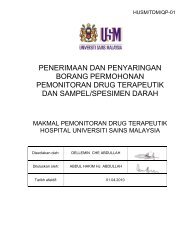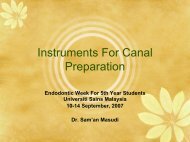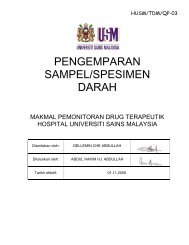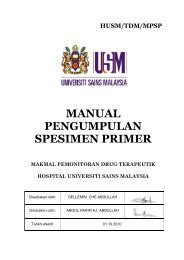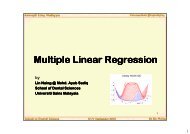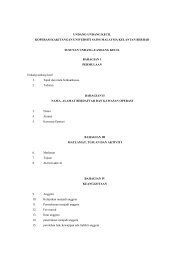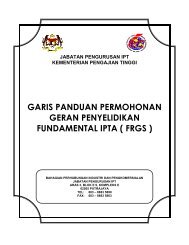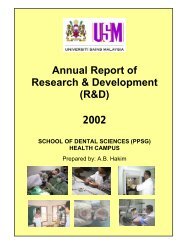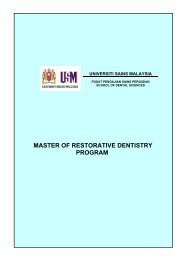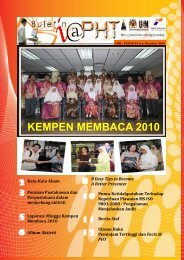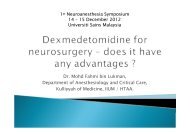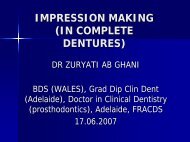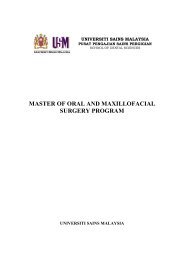Vol 11-R2- Eyelid
Vol 11-R2- Eyelid
Vol 11-R2- Eyelid
You also want an ePaper? Increase the reach of your titles
YUMPU automatically turns print PDFs into web optimized ePapers that Google loves.
SRPS • <strong>Vol</strong>ume <strong>11</strong> • Issue <strong>R2</strong> • 2010<br />
called the muscle of Riolan, is separated from the<br />
pretarsal component by the eyelash follicles and<br />
forms the gray line along the eyelid margins. 14,15<br />
Muzaffar et al. 16 reported that the orbicularisretaining<br />
ligament is a bilaminar septum-like<br />
structure attaching the orbicularis oculi to the<br />
inferior orbital rim. The attachment is weakest<br />
centrally and tightest over the inferolateral<br />
orbital rim.<br />
Ghavami et al. 17 further clarified that the<br />
orbicularis-retaining ligament is a circumferential,<br />
periorbital structure and that the orbicularis<br />
retaining ligament of the superior orbit arises 2 to 3<br />
mm above the orbital rim in the mid orbit.<br />
Anterior and Posterior Lamellae<br />
The eyelid is divided into two lamellae (Fig. 3). 13<br />
The anterior lamella consists of skin and the<br />
orbicularis oculi muscle, and the posterior lamella<br />
consists of the tarsal plate and conjunctiva. 15<br />
Tarsus<br />
The tarsal plates act as the skeleton of the eyelids,<br />
providing semirigid support. 18 The tarsus is<br />
composed of dense regular connective tissue and<br />
contains the Meibomian glands. 4 The superior tarsus<br />
is 10 to 12 mm at its greatest vertical dimension,<br />
and the inferior tarsus is 3 to 5 mm. 18 The upper<br />
and lower tarsal plates are similar in length (29 mm)<br />
and thickness (1 mm). 2 The Meibomian glands<br />
are modified holocrine sebaceous glands and are<br />
oriented vertically in parallel rows through the<br />
tarsus. The upper lid contains 25 meibomian glands,<br />
and the lower lid contains 20. 13<br />
Conjunctiva<br />
The palpebral conjunctiva lines the inner surface<br />
of the eyelids and is covered by a non-keratinized<br />
epithelium. Holocrine glands known as goblet<br />
cells secrete mucous and are located throughout<br />
the conjunctiva. The goblet cells are mainly<br />
concentrated in the conjunctival fornices and at the<br />
caruncle. The palpebral conjunctiva is continuous<br />
with the conjunctival fornices and merges with<br />
the bulbar conjunctiva overlying the globe. The<br />
4<br />
conjunctiva becomes freely mobile in the fornices.<br />
The bulbar conjunctiva lines the sclera and<br />
terminates at the limbus.<br />
Orbital Septum<br />
The orbital septum lies beneath the orbicularis<br />
muscle and consists of a thin sheet of connective<br />
tissue. It encircles the orbit as an extension of the<br />
periosteum of the roof and the floor of the orbit. 2<br />
The orbital septum acts as a barrier of the orbital<br />
contents, and the orbital fat can be found posterior<br />
to it. It extends from the arcus marginalis, where<br />
the periosteum and periorbita fuse, toward the<br />
tarsus. 3 In the upper eyelid the septum inserts at the<br />
levator, approximately 2 to 3 mm above the superior<br />
edge of the tarsus. In the lower eyelid, the septum<br />
inserts to the inferior edge of the tarsus. 19 The<br />
septum attaches medially to the lower end of the<br />
anterior lacrimal crest, called the lacrimal tubercle. It<br />
continues from the lower to upper eyelid by passing<br />
under the medial orbicularis muscle. 3 Putterman 19<br />
noted that the septum is difficult to trace laterally<br />
because it blends with the lateral canthal tendon<br />
and the lateral horn of the levator. The septum also<br />
takes the shape of an arch under the supraorbital<br />
notch and around the supratrochlear and<br />
infratrochlear nerves and vessels. Weakness in the<br />
orbital septum contributes to herniation of the<br />
orbital fat.<br />
Reid et al. 20 described a distinct fibrous<br />
anatomic layer, which extends from the orbital<br />
septum to cover the tarsus. They named the fibrous<br />
structure the septal extension. They described the<br />
preaponeurotic fat layer covered by the septal<br />
extension, which extends to cover the tarsus along<br />
its anterior border to the ciliary margin. The septal<br />
extension was found between the orbicularis<br />
oculi and the levator aponeurosis, distinct from<br />
the levator tissue. Fibrous connections extending<br />
from the levator aponeurosis penetrate the septal<br />
extension and the orbicularis muscle, connecting the<br />
levator-dermal link to the septal extension. Tension<br />
placed on the orbital septum leads to referred<br />
tension on the septal extension and secondary<br />
lagophthalmos. The authors stated that the findings



